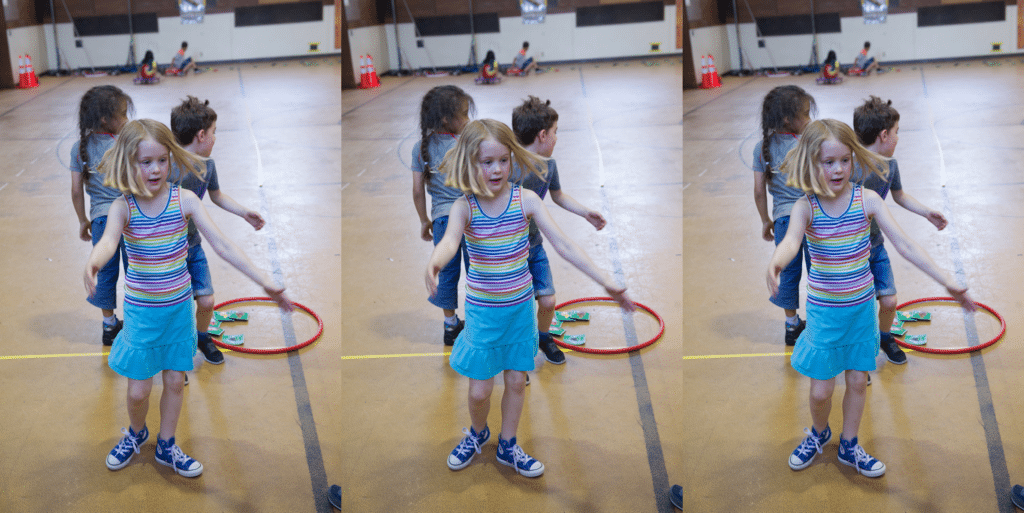
When I was a physical education teacher, I was always on the lookout for fun, cooperative games for my youngest students. I learned from experience that five- and six-year-olds need a great deal of physical activity, and they also have limited attention spans, so it was important to find games that provided opportunities for all children to be actively engaged. I also wanted my students to have experiences that would help them build the skills of cooperation, sharing, compromise, and encouragement, all of which are essential elements for developing a sense of community. So I looked for games with these elements and characteristics:
These were some of my all-time favorites:
You’ll need small hula hoops or rings scattered throughout the play area (one hoop per two children to start with). Use music or a signal to cue movement. Children move about the playing area, stepping anywhere except inside a hoop. On the teacher’s signal, or when the music stops, everyone finds a hoop and steps inside as quickly as possible. (Two or more children can be in the same hoop.) To be considered “inside” a hoop, a child must have at least one foot in. The other foot may not touch the ground outside the hoop. When the game continues, the teacher removes one hoop. Continue playing and removing hoops until children cannot possibly squeeze any more people into the remaining hoops.
Teaching Tip: Before and during the game, you’ll want to ask children to demonstrate how they’ll help each other get inside a hoop.
All children begin by standing in a circle, holding hands. A hula hoop (or rope loop) is placed over the arms of two players. The group’s challenge is to see how quickly their group can move the hula hoop around the circle without letting go of each other’s hands. To add an even more difficult challenge, start two hula hoops at the same time on opposite sides of the circle. Then send the hoops in different directions.
Teaching Tip: Consider starting with smaller groups of children (8-10), so that children are not waiting too long for their turn. You can work up to a larger group. Try adding the additional hoop after children are successful with passing one hoop in a smaller group.
One or more “its” are chosen randomly by the teacher to pursue the rest of the players. Be sure to have a quick, equitable system for selecting the “its,” such as drawing names or numbers. When tagged, the tagged player must freeze with his/her hands overhead. To be released, three classmates must join hands in a circle around the frozen player and shout, “1, 2, 3—YOU’RE FREE.”
Teaching Tip: Prior to playing the game, review “tagger’s choice” rule and “safe tags.” “Tagger’s choice” means the tagger has the last word on whether he/she tagged someone or not. “Safe tags” are done with two fingers on the shoulders or back. (Use interactive modeling to teach, review, and practice safe tags.)
Students try to pass a designated object (Frisbee, stuffed animal, etc.) around the circle without using their hands and without letting the object touch the floor.
Teaching Tip: Begin with smaller groups of 8-10 students each, so that “wait times” are not too long for younger children. Also, try adding additional objects (of different shapes or sizes) to be passed, so that more children are actively involved.
Players (children and adults) stand in a circle—holding hands. A balloon is dropped into the circle and players see how many times they can tap the balloon into the air without losing connection (everyone in the circle must continue holding hands). This will require that the circle move and players work cooperatively to keep the balloon in the air. Players may contact the balloon with hands, arms, heads, shoulders, chests, or knees—but not feet. If the balloon falls to the ground or is touched by feet, start the count over.
Teaching Tip: Try teaching balloon-tapping skills with children in pairs. (Use interactive modeling to teach and practice light and gentle tapping of the balloon.) Once they are successful at keeping their balloon in the air without dropping their partner’s hands, slowly increase the group size.
If you’re looking for cooperative game ideas, you might want to check out 99 Activities and Greetings and Energizers! They both include activities that younger or older students can play in the classroom, outdoors, or in a gymnasium.
Babs Freeman-Loftis is the coauthor of Responsive School Discipline.